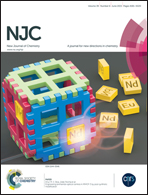Fluorescence detection of aromatic amines and photocatalytic degradation of rhodamine B under UV light irradiation by luminescent metal–organic frameworks†
Abstract
The detection of trace amounts of aromatic amines is significantly important for security concerns and pollution control. Two multifunctional metal–organic frameworks (MOFs), [ZnL·H2O]n (1) and [CdL·H2O]n·2nH2O (2) (L = 5-aminoisophthalic acid), were strategically chosen for the detection of aromatic amines pollutants. The fluorescent experiments show that the two MOFs can selectively detect aromatic amines with high sensitivity. Among the given analytes, p-nitroaniline, an electron-deficient analyte, significantly quenched the fluorescence intensities of 1 and 2. In contrast, other aromatic amines enhanced the fluorescence intensities of 1 and 2 to some extent. In particular, diphenylamine gives the most apparent enhancement effect than those of others under the same experimental conditions. Moreover, the photocatalytic activities of the two MOFs were also determined by UV light induced photodegradation of Rhodamine B (RhB) experiments. All the results indicate that the complexes studied are stable and good candidates for both as heterogeneous photocatalysts and detectable materials for aromatic amines.


 Please wait while we load your content...
Please wait while we load your content...